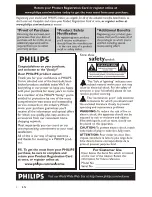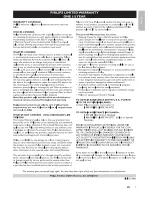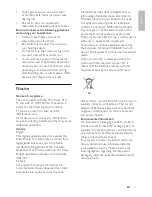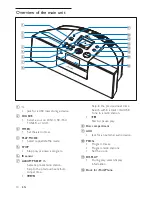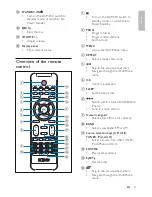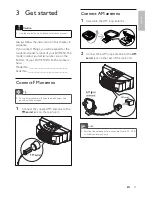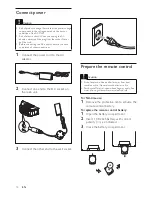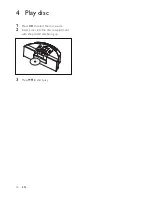
6
EN
m
Unplug this apparatus during lightning
storms or when unused for long periods
of time.
n
Refer all servicing to qualifi ed service
personnel. Servicing is required when
the apparatus has been damaged in any
way, such as power-supply cord or plug
is damaged, liquid has been spilled or
objects have fallen into the apparatus,
the apparatus has been exposed to rain
or moisture, does not operate normally,
or has been dropped.
o
Battery usage CAUTION – To prevent
battery leakage which may result in
bodily injury, property damage, or
damage to the unit:
Install all batteries correctly, + and -
•
as marked on the unit.
Do not mix batteries (old and new
•
or carbon and alkaline, etc.).
Remove batteries when the unit is
•
not used for a long time.
p
Apparatus shall not be exposed to
dripping or splashing.
q
Do not place any sources of danger on
the apparatus (e.g. liquid fi lled objects,
lighted candles).
r
This product may contain lead and
mercury. Disposal of these materials
may be regulated due to environmental
considerations. For disposal or recycling
information, please contact your local
authorities or the Electronic Industries
Alliance: www.eiae.org.
Where the MAINS plug or an appliance
•
coupler is used as the disconnect device,
the disconnect device shall remain readily
operable.
Warning
Never remove the casing of this DCM250.
•
Never lubricate any part of this DCM250.
•
Never place this DCM250 on other electrical
•
equipment.
Keep this DCM250 away from direct sunlight, naked
•
fl ames or heat.
Never look into the laser beam inside the DCM250.
•
Ensure that you always have easy access to the power
•
cord, plug or adaptor to disconnect the DCM250 from
the power.
Caution
Use of controls or adjustments or performance of
•
procedures other than herein may result in hazardous
radiation exposure or other unsafe operation.
Hearing safety
Listen at a moderate volume.
Using headphones at a high volume can
•
impair your hearing. This product can
produce sounds in decibel ranges that
may cause hearing loss for a normal
person, even for exposure less than a
minute. The higher decibel ranges are
offered for those that may have already
experienced some hearing loss.
Sound can be deceiving. Over time your
•
hearing ‘comfort level’ adapts to higher
volumes of sound. So after prolonged
listening, what sounds ‘normal’ can
actually be loud and harmful to your
hearing. To guard against this, set your
volume to a safe level before your hearing
adapts and leave it there.
To establish a safe volume level:
Set your volume control at a low setting.
•
Slowly increase the sound until you can
•
hear it comfortably and clearly, without
distortion.
Listen for reasonable periods of time:


